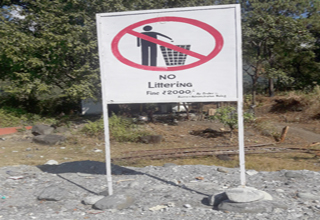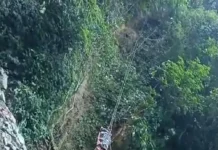[ Karyir Riba ]
ROING, Jan 11: The best thing that Lower Dibang Valley district witnessed in the past year was the opening of the Dr Bhupen Hazarika Bridge in May 2017.
The gruesome ferry rides over the Lohit river, especially during the rainy seasons, have become a thing of the past, but still remain in the minds of the people who had endured them for decades.
Not only has the bridge provided relief from the tedious journey to Tinsukia (the nearest business hub in neighbouring Assam), it has cut the travelling time to less than half. Be it business or leisure – most importantly, medical – trips have become immensely convenient.
However, all things good come at a price! And this has been proved correct with the current situation in the district.
The unexpected tourist influx in a humongous number has left the denizens perplexed. What at first seemed like a prospect to a booming tourism industry has turned out to be a matter of huge concern.
The district that had just begun to be developing in terms of hygiene and sanitation, has been feeling the brunt of the unaware and careless attitude of the tourists regarding the cleanliness of the areas they visit.
As per reports, on weekdays the district easily receives more than 300 vehicles, including buses, per day, which goes up to a whopping 1000 or more vehicles during the weekends!
Consequently, the traffic in the town is also chaotic, especially in the absence of traffic wardens that the town lacks.
The hotspots for the tourists at the moment are the Eze Park, the Eze river and, of course, the snow-clad Mayudia. The tourists who visit these places because of their scenic beauty obviously do not have respect for the same, as can be seen from how these places have been treated in the past few months.
The signboards warning against littering put up by the district administration at the tourist spots seem to be invisible to these visitors. These signboards even say that a fine of Rs 2000 will be applied if anyone is found littering. Ironically, there is no one to keep a vigil for the offence, and the tourists seem to take a liking to living life on the edge by breaking rules!
The banks of the Eze river lies in a pathetic condition as thousands of tourists enjoy picnicking here. Not only would one be disgusted by the amount of non-degradable garbage that they leave behind, mounds of human excreta can be found lying everywhere that can make the bravest of the man squeamish to the core.
This condition prevails not only on the banks of the Eze river; the same scenario can be witnessed at the Chipu river, the Dibang river, and the Epi river. Sadly, even the scenic Mayudia has not been left unhurt by these murderers of nature.
The menace is such that the locals have no place to go for outings any more, especially during weekends. All the areas are overcrowded with people, and the roads congested with vehicles. The fear of bumping into human excreta during picnicking is another story!
Keeping these sanitation issues in the eco-sensitive areas in mind, the administration had circulated a ban on picnics on the banks of the Eze and the Chipu rivers. No heed was paid to the administrative order, and both the places continued to be abused by tourists.
However, a little change can be expected as the DA has now started to deploy two guards at a time to check alcohol consumption and picnicking at the Eze river. The number of the guards seems to be meagre though, especially during the weekends.
Instead of banning picnics, why not specify a particular area for picnicking, and charge a fee to maintain the spot?
Complete lack of civic sense is evident in these tourists. Improper parking habits have caused a lot of pain for the townspeople. What is more painful is the reckless driving that they practice. It is not exaggerated to inform here that vehicular accidents have been occurring on a daily basis since the tourist influx, and all of the accidents involve at least one Assam registered vehicle.
The police department has been doing a fair job in at least taking care of the rash driving by installing a number of barricades at various places on the highway, from Shantipur check gate to the Eze bridge.
Availability of alcohol at a cheaper rate in Arunachal Pradesh, compared to Assam, seems to have made some ‘alcohol loving’ tourists very happy. Reportedly, this section of tourists has been seen filling their cars’ boots with cartons and cartons of alcohol to take back home. Some have also been reported to have been brandishing firearms. Their behaviour towards the locals can be termed as being very indifferent.
All these problems, especially the disrespect and vandalism of the local ecology, have caused worry and frustration amongst the locals of the district.
The apex body of the Idu-Mishmi community has stepped in to check the matter before the situation gets worse. The Idu Mishmi Cultural and Literary Society (IMCLS) put down a few suggestions before the Roing ADC to curb the menace.
The IMCLS suggested that the first and foremost thing to do is to put an immediate stop on the temporary ILPs being issued at the check gate by circumventing due procedure, and it should be made available only from the DC’s office in Roing through acquaintances or tour operators.
The e-ILP may also be procured, it has suggested, adding that local youths or NGO members may be engaged as eco-volunteers and traffic volunteers. The IMCLS has also called for initiating sanitation drives under strict supervision and regulation of the DA. Car entry fee being collected at the check-gate may be utilized for the purpose, if collected under a specific head of account maintained by the DA, it suggested.
The IMCLS has, very aptly, suggested that the by-pass road should be utilized to decongest traffic. This suggestion stands truly appropriate for all parties as the bypass road leads straight to the present tourist hotspots.
Other suggestions of the IMCLS include increasing the much-needed strength of traffic police and posting of paramilitary at the check gate.
The All Idu Mishmi Student’s Union (AIMSU) had also earlier served a letter to the DA regarding the matter, especially regarding the senseless picnicking and littering by tourists.
Having said all this, positive changes can be noticed in terms of economic development as a number of eateries have come up since the inflow of tourists. However, this little economic development is coming at what price is the real question.
With the frustration of the local denizens building up, and regular reports of behaviour issues of tourists, the situation here is like a mishap waiting to occur. Hope that the DA gives a thought to the suggestions from the IMCLS, devises some ideas to make use of the growing tourism for the benefit of the district, and resolves a solution to check reckless driving and sanitation issues at the earliest, taking into consideration the sentiments of all parties involved.




